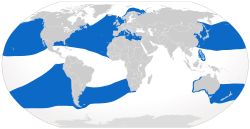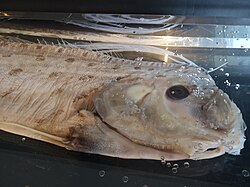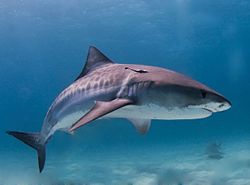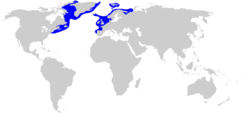This list includes extant fish with reported maximum length more than 6 metres.
| Rank | Animal | Scientific name | Maximum length | Image | Habitat |
|---|---|---|---|---|---|
| 1 | Whale shark | Rhincodon typus | 18.8 m (62 ft) (see Whale shark) [1] |  |  |
| 2 | Basking shark | Cetorhinus maximus | 12.27 m (40.3 ft) [2] |  |  |
| 3 | Giant oarfish | Regalecus glesne | 11 m (36 ft) [3] |  | |
| 4 | Russell's oarfish | Regalecus russellii | 8 m (26 ft) [4] |  | |
| 5 | Largetooth sawfish | Pristis pristis | 7.5 m (25 ft) [5] |  | |
| 6 | Tiger shark | Galeocerdo cuvier | 7.4 m (24 ft) [6] |  |  |
| 7 | Longcomb sawfish | Pristis zijsron | 7.3 m (24 ft) [7] |  | |
| 8 | Greenland shark | Somniosus microcephalus | 7.3 m (24 ft) [8] |  |  |
| 9 | Beluga sturgeon | Huso huso | 7.2 m (24 ft) [9] |  |  |
| 10 | Great white shark | Carcharodon carcharias | 7.1 m (23 ft) (disputed) [10] [11] [12] |  |  |
| 11 | Pacific sleeper shark | Somniosus pacificus | 7 m (23 ft) [13] |  |  |
| 12 | Common thresher shark | Alopias vulpinus | 6.5 m (21 ft) [14] |  |  |
| 13 | Goblin shark | Mitsukurina owstoni | 6.2 m (20 ft) [15] |  |  |
| 14 | Great hammerhead shark | Sphyrna mokarran | 6.1 m (20 ft) [16] |  |  |
| 15 | White sturgeon | Acipenser transmontanus | 6.1 m (20 ft) [17] |  | |
| 16 | Bluntnose sixgill shark | Hexanchus griseus | 6.1 m (20 ft) [18] |  |  |
| 17 | European sea sturgeon | Acipenser sturio | 6 m (20 ft) [19] |  |